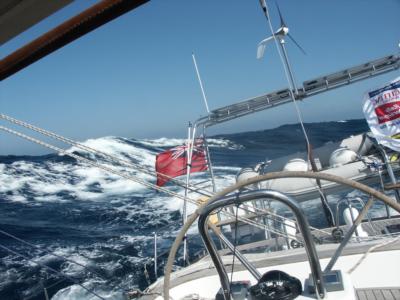
The Bay of Biscay is notorious from the days of the square-rigged sailing ships, which because of their wide tacking angle could become 'embayed'; trapped in the Bay and unable to clear either Ushant or Cape Finisterre. Modern yachts don't suffer this problem, but the words 'Bay of Biscay' still gets sailors' pulses quickening.
In actual fact, the Bay of Biscay is like any stretch of open water when it starts to get windy. Conditions can change quickly and because of certain geographical features, can become rather uncomfortable.
The Bay of Biscay is a wide concave sweep of water that stretches around the western coast of France and along the northern coast of Spain. Combine this geography with the prevailing westerly winds that sweep in from the Atlantic, and you have one long, 310-mile lee shore. Naturally sailing ships of old had a great fear of getting embayed here after a succession of westerly gales, but the Bay is also notorious for its stormy waters, driven up as the Atlantic Ocean meets the shallower continental shelf of the Bay. Modern yachts, with their much more efficient rigs and their engines, should not have the same problems - particularly if they use weather forecasts carefully.
All the books say it is important to get across the Bay of Biscay before the middle of August, in order to avoid the risk of the first storms of the autumn, with June and July being the best months to cross. This is perfect timing for Rally Portugal, which departs from Plymouth, UK at the beginning of June. Not only is this a recommended time to cross the Bay of Biscay, but it also gives the Rally good sailing down the coast of Portugal with the northern trade winds, and time to do some summer cruising further a field once the Rally ends in Lagos at the end of June.
 The "traditional" route for sailing vessels is to depart the Channel, going west of Ushant and out to or a little further than 10º W. The advantage to this tactic is that by keeping far out a yacht will not be prone to the effects of any steepening of the Atlantic swell in the Bay. The first landfall for the Rally is on the west coast of the Iberian Peninsula in Bayona so care should be taken when approaching the Atlantic coast off Cape Finisterre. This Cape is a renowned area for strong winds, typically blowing several Forces more than forecast. It is tempting for yachts to “cut the corner” to Bayona by sailing close to Cape Finisterre, however a safer option is to keep a good distance off and preserve the sails and crew’s nerves!
The "traditional" route for sailing vessels is to depart the Channel, going west of Ushant and out to or a little further than 10º W. The advantage to this tactic is that by keeping far out a yacht will not be prone to the effects of any steepening of the Atlantic swell in the Bay. The first landfall for the Rally is on the west coast of the Iberian Peninsula in Bayona so care should be taken when approaching the Atlantic coast off Cape Finisterre. This Cape is a renowned area for strong winds, typically blowing several Forces more than forecast. It is tempting for yachts to “cut the corner” to Bayona by sailing close to Cape Finisterre, however a safer option is to keep a good distance off and preserve the sails and crew’s nerves!
Although June is considered one of the best months to cross the Bay of Biscay, gales can still be possible, especially near the Spanish coast as the Spanish peninsula heat low deepens during the day, more so when the Azores high intensifies or moves a little to the east. On all Biscay crossings, ships and fishing boats are an ever-present problem.
Typical breakages that Rally yachts seem to suffer on the Biscay crossing include:
Engine failure – normally due to dirty fuel that has been mixed by the motion of the Atlantic swells, and then clogs the filters.
Lack of fuel – always over-estimate what you are going to need based on the forecast!
Rigging failures – a rig-check is a ‘must’ before departing from Plymouth (full details of how to do this before you leave port, plus a guide for a daily rig check at sea in Rally Handbook).
Sheared mainsail cars – if there is a big swell, then the strain on the rig is greater, so reef early or trim the sails to reduce the strain on gear. Its easy to be over-canvassed when reaching or running! Remember to take lots of spares.
Faulty autopilots– test, test and test again. Any new kit should be well tried and tested before undertaking a long passage. It is important to balance the sails to take the strain off the autopilot motor/rams - try putting in a reef, easing the mainsheet or rolling away a little foresail. Get the boat sailing smoothly without needing big helm corrections.
Even though the Bay is notourious for its bad weather and conditions there are also some amazing wonders of nature that can be seen such as the dolphins shown below seen from Rally Portugal yacht Gertha 4